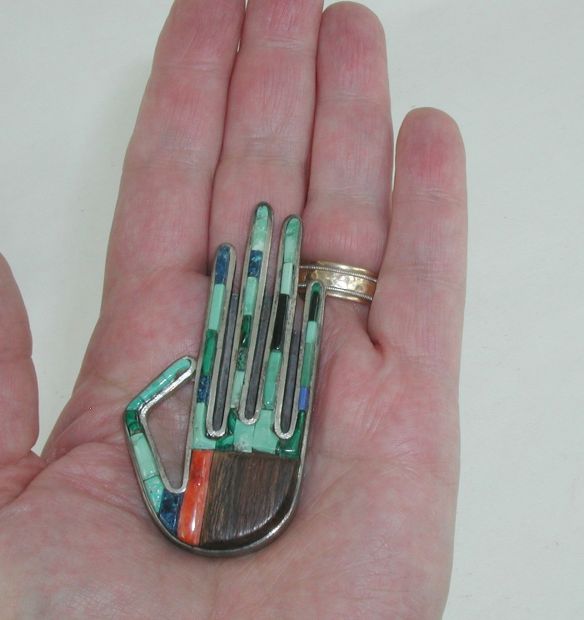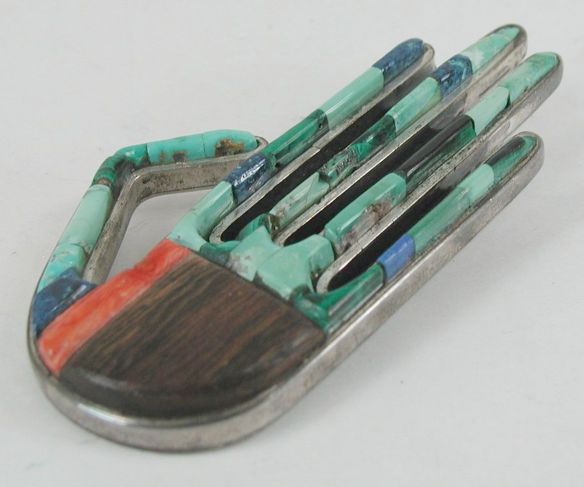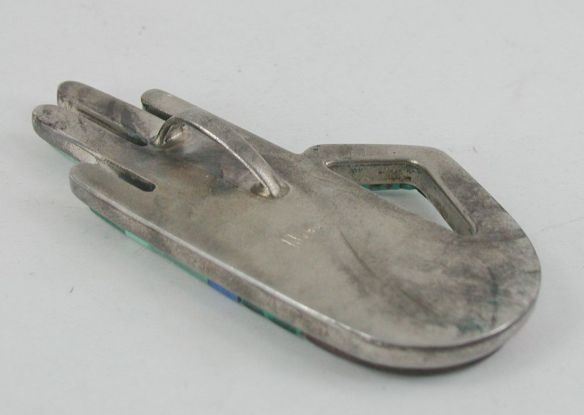When this piece arrived in an estate lot several years ago, I fell in love with it immediately – purely for its design and symbolism. I didn’t even look at the back – just thought it was an extraordinary piece.
Then I turned it over…..and………thought………..could it be?
I started googling and soon had a strong feeling this could be a piece by Hopi legend Charles Loloma.
So I wrote to the niece of Charles Loloma, Verma Nequatewa.
Sonwai is the artistic name used by Verma Nequatewa. Verma began working with her uncle, the late Charles Loloma, in the mid-1960’s and continued working with him until his studio closed in the early 1990’s. At that time, she opened her own studio and has been continuing his teachings through her own jewelry.
Here is the reply I received from Bob Rhodes in response to my photos and email to Verma : “The pendant has a tufa-cast back and inlay of turquoise, lapis lazuli, coral and ironwood. It is difficult to see the detail in the photo, so I may have missed something.
The piece represents what Charles called a “Badger Hand.” Charles was Badger clan and this is his concept of a combination of badger paw and human hand. It was most likely made at the Loloma Studio at Hotevilla, AZ in the late 1960’s or early 1970’s. At that time he often did not differentiate between turquoise from different mines. He had a wash basin that he put all sorts of turquoise in, then picked pieces out for different colors and shapes. He did only use natural, not treated, turquoise, so some of the stones will “mature” or change color as they are exposed to light, air and skin oils. What you have is a very representational piece of Loloma jewelry of that time period. ”
Well I got goose bumps and thanked them both so much for the thoughtful and detailed reply.
They appreciated the photos as they are collecting as many as they can of Charles Loloma’s pieces.
Charles Loloma (1921-1991) was an active Hopi artist from 1949-1991. He is one of the most innovative and influential Native American artists of his time. He used many techniques including tufa casting, lost wax casting, stone and wood inlay, and cobblestone.
Although he was also a painter and ceramicist, he is most well known for his jewelry.
This badger paw pendant is an example of the high stone-to-stone inlay he became so well-known for.
According to Loloma himself, “I am not versed in the exact date that I started working in jewelry, but my guess is it was in 1947 when I was a student at Alfred University. I was working in pottery and silver.”
In the mid 1950s Loloma moved to Scottsdale, Arizona and began making jewelry in earnest.
The name Loloma translates to “many beautiful colors” which is certainly evident in his work. He broke from the tradition of solely using turquoise and coral by adding unusual stones of bright color as well as fossilized ivory and imported woods such as iron wood.
Much has been written about Charles Loloma – see Southwestern Indian Jewelry, Crafting New Traditions by Dexter Cirillo.
Paula







What an amazing find! Thank you for sharing this information with us.
Paula, this is remarkable. Looks like very contemporary art. I LOVE it!
Wow! I’d say that’s a find of the century! And to receive affirmation from the family, even better! I do like the way the turquoise has turned colors since it is untreated, and I’ve got several small rings that have done that as well. Makes them interesting. One question though as I’ve noticed on my rings….the smaller stones begin cracking badly even though I’ve not worn them in years. I live in dry Colorado. Is there a way to protect your Loloma piece to potentially avoid that? Don’t sell it, keep it and display it maybe in a shadow box! For me it would be one of those once in a lifetime opportunities…unless of course, you get another lucky lot!
Thanks !
We are also in Colorado. The best way to preserve the stones is to keep them away from moisture, skin oils, cosmetics and sunlight !
I would like to find out the price value for my turquiose necklace. And also what does the most expensive turquiose looks like? Thankyou,